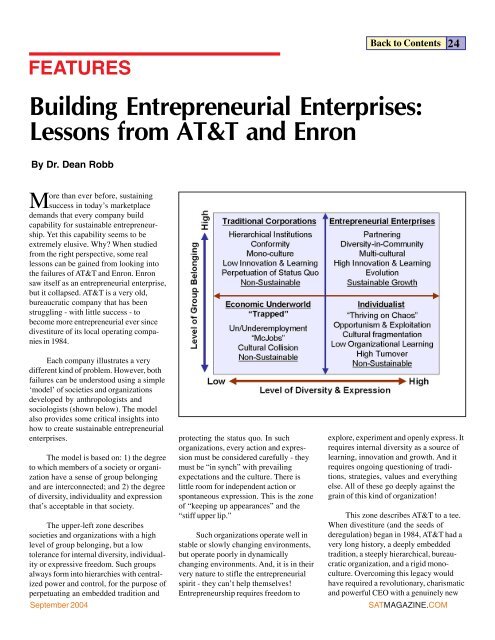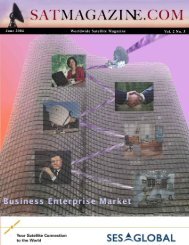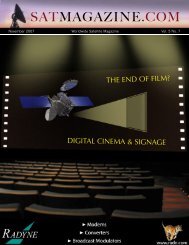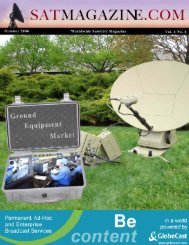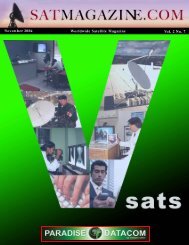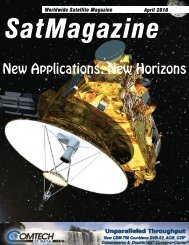September 2004 - SatMagazine
September 2004 - SatMagazine
September 2004 - SatMagazine
You also want an ePaper? Increase the reach of your titles
YUMPU automatically turns print PDFs into web optimized ePapers that Google loves.
FEATURES<br />
Back to Contents<br />
24<br />
Building Entrepreneurial Enterprises:<br />
Lessons from AT&T and Enron<br />
By Dr. Dean Robb<br />
More than ever before, sustaining<br />
success in today’s marketplace<br />
demands that every company build<br />
capability for sustainable entrepreneurship.<br />
Yet this capability seems to be<br />
extremely elusive. Why? When studied<br />
from the right perspective, some real<br />
lessons can be gained from looking into<br />
the failures of AT&T and Enron. Enron<br />
saw itself as an entrepreneurial enterprise,<br />
but it collapsed. AT&T is a very old,<br />
bureaucratic company that has been<br />
struggling - with little success - to<br />
become more entrepreneurial ever since<br />
divestiture of its local operating companies<br />
in 1984.<br />
Each company illustrates a very<br />
different kind of problem. However, both<br />
failures can be understood using a simple<br />
‘model’ of societies and organizations<br />
developed by anthropologists and<br />
sociologists (shown below). The model<br />
also provides some critical insights into<br />
how to create sustainable entrepreneurial<br />
enterprises.<br />
The model is based on: 1) the degree<br />
to which members of a society or organization<br />
have a sense of group belonging<br />
and are interconnected; and 2) the degree<br />
of diversity, individuality and expression<br />
that’s acceptable in that society.<br />
The upper-left zone describes<br />
societies and organizations with a high<br />
level of group belonging, but a low<br />
tolerance for internal diversity, individuality<br />
or expressive freedom. Such groups<br />
always form into hierarchies with centralized<br />
power and control, for the purpose of<br />
perpetuating an embedded tradition and<br />
<strong>September</strong> <strong>2004</strong><br />
protecting the status quo. In such<br />
organizations, every action and expression<br />
must be considered carefully - they<br />
must be “in synch” with prevailing<br />
expectations and the culture. There is<br />
little room for independent action or<br />
spontaneous expression. This is the zone<br />
of “keeping up appearances” and the<br />
“stiff upper lip.”<br />
Such organizations operate well in<br />
stable or slowly changing environments,<br />
but operate poorly in dynamically<br />
changing environments. And, it is in their<br />
very nature to stifle the entrepreneurial<br />
spirit - they can’t help themselves!<br />
Entrepreneurship requires freedom to<br />
explore, experiment and openly express. It<br />
requires internal diversity as a source of<br />
learning, innovation and growth. And it<br />
requires ongoing questioning of traditions,<br />
strategies, values and everything<br />
else. All of these go deeply against the<br />
grain of this kind of organization!<br />
This zone describes AT&T to a tee.<br />
When divestiture (and the seeds of<br />
deregulation) began in 1984, AT&T had a<br />
very long history, a deeply embedded<br />
tradition, a steeply hierarchical, bureaucratic<br />
organization, and a rigid monoculture.<br />
Overcoming this legacy would<br />
have required a revolutionary, charismatic<br />
and powerful CEO with a genuinely new<br />
SATMAGAZINE.COM


